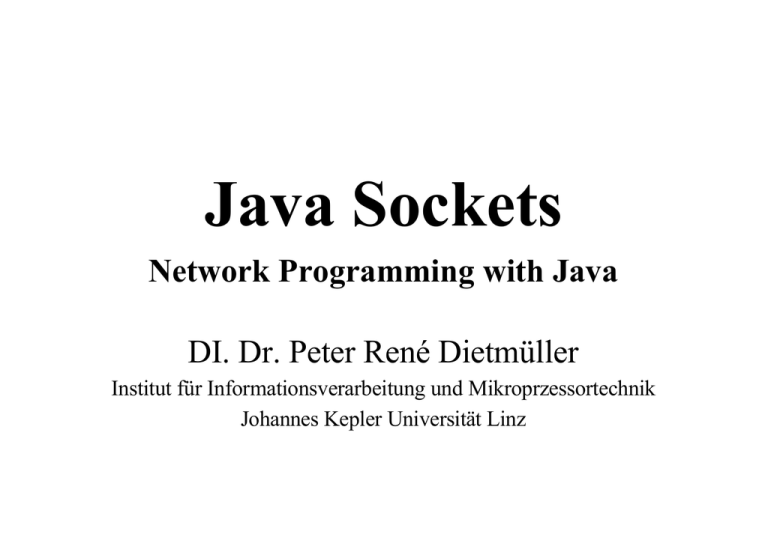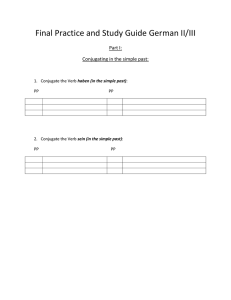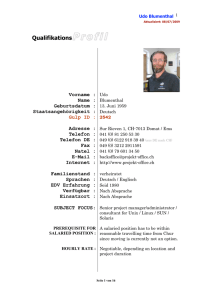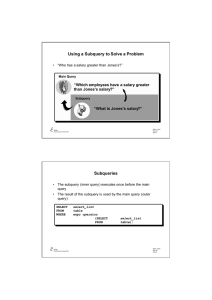Network Programming with Java DI. Dr. Peter René Dietmüller
Werbung

Java Sockets Network Programming with Java DI. Dr. Peter René Dietmüller Institut für Informationsverarbeitung und Mikroprzessortechnik Johannes Kepler Universität Linz Überblick Ø Ø Ø Ø Ø Ø TCP-Kommunikation UDP-Kommunikation Klasse Socket Klasse ServerSocket Klasse DatagramPacket Klasse DatagramSocket © Peter René Dietmüller Java Sockets Seite 2 TCP-Kommunikation Klasse Socket öffnen Socket benennen Socket verbinden Daten senden, empfangen Socket schließen © Peter René Dietmüller Client Socket Konstruktor --getInputStream() / getOutputStream() close() Java Sockets Server ServerSocket Konstruktor -accept() getInputStream() / getOutputStream() close() Seite 3 UDP-Kommunikation Klasse Socket öffnen Socket benennen Socket verbinden Daten senden, empf. Socket schließen © Peter René Dietmüller Client DatagramSocket, DatagramPacket Konstruktor --send() / receive() close() Java Sockets Server DatagramSocket, DatagramPacket Konstruktor --send() / receive() close() Seite 4 Socket (1) public Socket(InetAddress address, int port) throws IOException Parameter: ♦ address - the IP address. ♦ port - the port number. Throws: ♦ IOException - if an I/O error occurs when creating the socket. ♦ SecurityException - if a security manager exists and its checkConnect method doesn't allow the operation. © Peter René Dietmüller Java Sockets Seite 5 Socket (2) public Socket(String host, int port) throws UnknownHostException, IOException Parameters: ♦ host - the host name. ♦ port - the port number. Throws: ♦ IOException - if an I/O error occurs when creating the socket. ♦ SecurityException - if a security manager exists and its checkConnect method doesn't allow the operation. Example: Socket s = new Socket(„www.fim.uni-linz.ac.at“, 80) © Peter René Dietmüller Java Sockets Seite 6 Socket (3) public Socket(String host, int port, InetAddress lAddr, int lPort) throws IOException Parameters: ♦ host - the name of the remote host ♦ port - the remote port ♦ lAddr - the local address the socket is bound to ♦ lPort - the local port the socket is bound to Throws: ♦ SecurityException - if a security manager exists and its checkConnect method doesn't allow the operation. © Peter René Dietmüller Java Sockets Seite 7 Method getInputStream public InputStream getInputStream() throws IOException Returns: ♦ an input stream for reading bytes from this socket. Throws: ♦ IOException - if an I/O error occurs when creating the input stream. Example: BufferedReader sin = new BufferedReader( new InputStreamReader(s.getInputStream())); zeile = sin.readLine(); © Peter René Dietmüller Java Sockets Seite 8 Method getOutputStream public OutputStream getOutputStream() throws IOException Returns: ♦ an output stream for writing bytes to this socket. Throws: ♦ IOException - if an I/O error occurs when creating the output stream. Example: PrintWriter sout = new PrintWriter(s.getOutputStream(), true); sout.println(zeile); © Peter René Dietmüller Java Sockets Seite 9 Method close public void close() throws IOException Throws: ♦ IOException - if an I/O error occurs when closing this socket. © Peter René Dietmüller Java Sockets Seite 10 ServerSocket (1) public ServerSocket(int port) throws IOException Parameters: ♦ port - the port number, or 0 to use any free port. Throws: ♦ IOException - if an I/O error occurs when opening the socket. ♦ SecurityException - if a security manager exists and its checkListen method doesn't allow the operation. Example: ServerSocket s = new ServerSocket(80); © Peter René Dietmüller Java Sockets Seite 11 ServerSocket (2) public ServerSocket(int port, int backlog) throws IOException Parameters: ♦ port - the specified port, or 0 to use any free port. ♦ backlog - the maximum length of the queue. Throws: ♦ IOException - if an I/O error occurs when opening the socket. ♦ SecurityException - if a security manager exists and its checkListen method doesn't allow the operation. © Peter René Dietmüller Java Sockets Seite 12 Method accept public Socket accept() throws IOException Throws: ♦ IOException - if an I/O error occurs when waiting for a connection. ♦ SecurityException - if a security manager exists and its checkListen method doesn't allow the operation. Example: ServerSocket ss = new ServerSocket(80); Socket s = ss.accept(); /* blocks until a connection is made */ © Peter René Dietmüller Java Sockets Seite 13 DatagramPacket (1) public DatagramPacket(byte[] buf, int length) Parameters: ♦ buf - buffer for holding the incoming datagram. ♦ length - the number of bytes to read. Example: /* -- Packet for receiving data -- */ p = new DatagramPacket(d, d.length); © Peter René Dietmüller Java Sockets Seite 14 DatagramPacket (2) public DatagramPacket(byte[] buf, int length, InetAddress address, int port) Parameters: ♦ buf - the packet data. ♦ length - the packet length. ♦ addr - the destination address. ♦ port - the destination port number. Example: p = new DatagramPacket(d, d.length, adr, port); © Peter René Dietmüller Java Sockets Seite 15 DatagramSocket (1) public DatagramSocket() throws SocketException Throws: ♦ SocketException - if the socket could not be opened, or the socket could not bind to the specified local port. ♦ SecurityException - if a security manager exists and its checkListen method doesn't allow the operation. Example: s = new DatagramSocket(); © Peter René Dietmüller Java Sockets Seite 16 DatagramSocket (2) public DatagramSocket(int port) throws SocketException Parameters: ♦ port - port to use. Throws: ♦ SocketException - if the socket could not be opened, or the socket could not bind to the specified local port. ♦ SecurityException - if a security manager exists and its checkListen method doesn't allow the operation. Example: s = new DatagramSocket(1920); © Peter René Dietmüller Java Sockets Seite 17 Method send public void send(DatagramPacket p) throws IOException Parameters: ♦ p - the DatagramPacket to be sent. Throws: ♦ IOException - if an I/O error occurs. ♦ SecurityException - if a security manager exists and its checkMulticast or checkConnect method doesn't allow the send. Example: (assuming that d is a byte array) s.send(new DatagramPacket(d, d.length, adr, port)); © Peter René Dietmüller Java Sockets Seite 18 Method receive public void receive(DatagramPacket p) throws IOException Parameters: ♦ p - the DatagramPacket into which to place the incoming data. Throws: ♦ IOException - if an I/O error occurs. Example: (assuming that d is a byte array) s = new DatagramSocket(PORT); p = new DatagramPacket(d, d.length); s.receive(p); s.close(); © Peter René Dietmüller Java Sockets Seite 19











